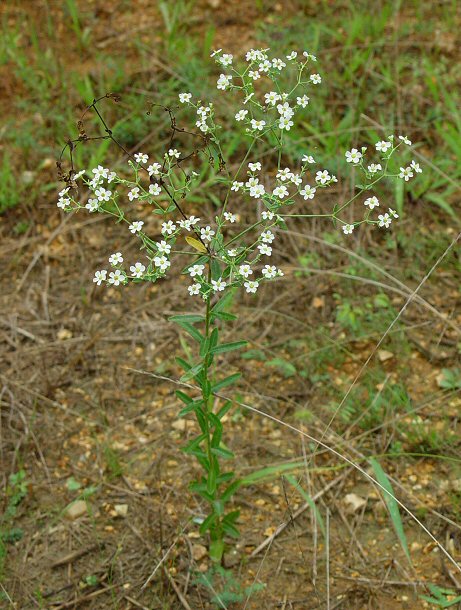Euphorbia corollata L.
Flowering Spurge

Native
CC = 3
CW = 5
MOC = 94
© DETenaglia
Euphorbia corollata L.Flowering Spurge | |
 |
Native CC = 3 CW = 5 MOC = 94 |
© DETenaglia |
|
Family - Euphorbiaceae Habit - Perennial forb with milky sap, with a deep, spreading, usually branched rootstock. Stems - Ascending to erect, to 1 m, unbranched below the inflorescence or occasionally few-branched, usually green to yellowish green or tan, glabrous or less commonly sparsely to moderately pubescent with slender, mostly spreading hairs, sometimes glaucous.
Leaves - Alternate below, often opposite or whorled in and near inflorescence, simple, entire, sessile or nearly so. Stipules absent or a pair of minute, light brown, convex to conical, sessile glands. Leaf blades 10-60 mm long, unlobed, the margins entire, the surfaces glabrous or sparsely to moderately pubescent with slender, mostly spreading hairs, green to bright green; those below the inflorescence narrowly lanceolate to more commonly oblong, oblong-oblanceolate or elliptic, mostly tapered at the base, rounded or short-tapered to a sharply pointed tip; those along the inflorescence branches narrowly elliptic to elliptic or narrowly ovate, rounded or angled at the base, angled to a bluntly or sharply pointed tip.
Inflorescence - Terminal umbellate panicles with a whorl of leaves at the base and each of the 3-6 primary branches usually branched 3-5 additional times, the cyathia solitary at the branch tips and branch points.
Flowers - Involucre 1.2-1.8 mm long, glabrous or the outer surface minutely hairy toward the rim, the rim shallowly 5-lobed, the margin minutely fringed or hairy, the marginal glands 5, 0.5-1.0 mm long, narrowly elliptic to nearly linear, yellowish green to green, with a conspicuous white petaloid appendage 1.5-4.5 mm long, glabrous, often notched at apex. Staminate flowers 10-21 per cyathium. Ovaries glabrous, the 3 styles 0.7-1.0 mm long, each divided 1/3-1/2 of the way from the tip into 2 relatively stout lobes, these sometimes somewhat club-shaped.
Fruit - Capsules 2.5-4.5 mm long, 3-lobed, glabrous. Seeds 1 per locule, 2.5-2.8 mm long, oblong-elliptic to broadly ovate in outline, nearly circular in cross section, rounded or somewhat angled at the base, the surface smooth or with shallow, faint pits, purplish brown but usually with a thin, white coating, lacking a caruncle.
Flowering - May - October. Habitat - Upland prairies, glades, bluffs, savannas, forest openings, streambanks, pastures, fields, fencerows, railroads, roadsides. Origin - Native to the U.S. Lookalikes - None close. Other info. - This is one of the showier of Missouri's euphorbs, by virtue of the white appendages which are technically not petals. It occurs throughout Missouri and most of the eastern half of the continental U.S. The plant is recognized by its oblong leaves, which typically change from an alternate arrangement near the base of the plant to opposite or whorled in the inflorescence, and its panicles of white "flowers." The sap is milky and sticky, and, like that of most other euphorbs, irritant and somewhat toxic. Photographs taken at the Current River Conservation Area, Reynolds County, MO., 8-10-1, and in Brown Summit, NC., 6-18-02 (DETenaglia); also at Taum Sauk State Park, Iron County, MO, 8-4-2020, Glassberg Conservation Area, Jefferson County, MO, 8-5-2020, Valley View Glade Natural Area, Jefferson County, MO, 8-14-2020, and Sand Prairie Conservation Area, Scott County, MO, 9-7-2020 (SRTurner). |